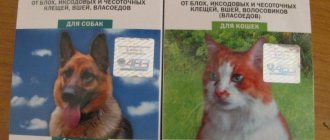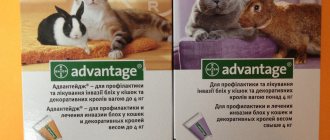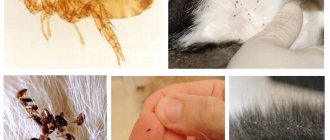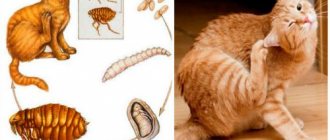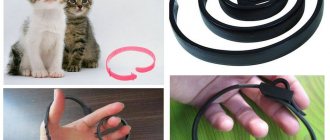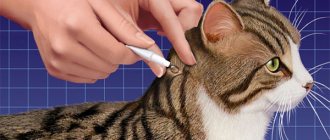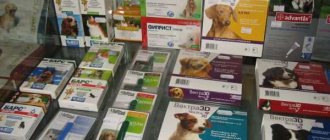Drops
Drops can be used for treatment after a veterinarian's prescription, because
some of them enter the bloodstream. Pay attention to the composition: it should be as gentle and low-toxic as possible. Here is a list of what drops can be used to treat fleas on a nursing cat:
Inspector. A low-toxic but effective drug, it is harmless, therefore it is allowed to be used when it is necessary to poison fleas on a pregnant or lactating cat over 4 kg. The dosage is prescribed in the instructions; apply drops to the skin of the animal, spreading the fur at the withers. Kills fleas and helminths, the result lasts for two months. In the room you need to treat the rug, bed, upholstered furniture, carpets, otherwise the parasites will again annoy the animal. Carry out daily wet cleaning.
Advantage, after application, quickly covers the skin with an invisible protective layer. Highly effective, does not enter the bloodstream, therefore safe for pregnant and lactating animals. The fleas die completely after twelve hours. The product should be dripped onto the withers without rubbing. Moisture-resistant, do not wash off even when the cat is exposed to rain or snow. The results will last for two months and apply to kittens.
When applying, it is important to observe safety precautions, make sure that the animal does not lick the drug; for this you can wear a collar.
Frontline. After conducting repeated laboratory studies, it was considered one of the safest products intended for eliminating parasites on cats during pregnancy and nursing kittens.
Please read the instructions carefully before use. Frontline is sold in a soft ampoule. After opening, you need to spread the fur on the withers, it is important that the pet subsequently cannot reach this place with its tongue, apply the required amount to the withers and between the shoulder blades. It is evenly distributed over the skin of the animal throughout the day, leading to the death of insects. The effect lasts for two months.
Stronghold is an effective remedy that helps kill fleas. Does not cause adverse reactions and is well tolerated by pregnant animals. Apply to the withers, dry quickly, there are no oils in the composition, so it does not stain the coat. Valid for a month.
Other drops also worked well:
- Blokhnet;
- Dana Ultra Neo;
- Rolf Club 3D;
- Delix;
- Drops on the withers 4 with a tail;
- Barrier;
- Helmintal;
- Celandine.
If fleas appear on a nursing cat or kittens, do not panic. The choice of anti-flea drops in veterinary pharmacies today is small, but compared to other drugs they act quickly, are well tolerated by kittens, and do not cause allergies. Protects against the appearance of new parasites for up to two months. This time will be enough for the kittens to get stronger, grow up and find loving homes.
How to use correctly
Stronghold is applied to the skin of the withers (lower part of the neck) monthly. To open a plastic pipette, hold it upright and push down on the cap until the small tip on the cap breaks the seal on the pipette. Part the fur and squeeze the entire contents of the dropper onto the skin just above the shoulder blades, where your pet won't be able to lick it off.
Stronghold is available in a variety of package sizes so that dogs and cats of varying weights can be dosed accordingly.
Each Stronghold size is color coded on the packaging for easy identification. A summary of how much of the drug is required for different sizes of dogs and cats is given in the table below.
Pros and cons of using drops
In veterinary medicine, such a flea remedy as drops is common. Their advantages:
- ease of use;
- versatility - the drops additionally protect the cat from ticks, lice, lice and helminths;
- effectiveness - repeated prophylaxis should be carried out after 2-3 months (for each drug, the duration of action is indicated in the instructions).
Disadvantages of drops:
- most products are contraindicated in kittens under 12 weeks of age and pregnant cats;
- toxicity - at least 2-3 days must pass from the last bath of the animal until treatment with drops, so that a protective fat layer has time to form.
Applying drops to the cat's fur.
Operating principle
Drops from entomosis, falling on the surface of the skin, are immediately absorbed and begin to accumulate in the sebaceous glands. After this, the medicine is gradually released, providing protection against parasitic insects for a long period.
Components of drip preparations
The main components of drip preparations for cats:
- Invermectin. Destroys microorganisms.
- Permethrin. An insecticide that is safe for both animals and humans.
- Pyriproxyfen. Component used as a basis for antiparasitic drops.
- Fipronil. Prevents re-infection.
Due to these components, the room in which the animal lives is disinfected.
Flea drops for kittens - the most convenient, effective and safest means
By having a pet, a person takes full responsibility for its life and health.
And if this is a small kitten, then it will need to be given much more attention than an adult cat. Having noticed unusual behavior of the animal (severe scratching, unusual sounds when biting), we can assume that the kitten has fleas, which can be gotten rid of by experienced veterinarians. After all, the appearance of insects such as fleas in a one-month-old kitten can pose a great danger to its life, so you should not delay treatment. According to experts, the most convenient, effective and safe flea treatments for kittens are drops. Since they are applied to the animal’s withers, it is practically impossible to lick them off, and the risk of poisoning is minimal. In veterinary pharmacies, flea drops for kittens are presented in a huge assortment; you can choose them for a certain age of the animal, hair length, weight and even breed. You may also be interested in the article “How to choose and how to apply flea drops for dogs?”
Why fleas are dangerous for a pregnant cat and newborn kittens
A flea is a blood-sucking insect that is a carrier of diseases, helminths, and poses a particular danger to kittens that have just been born. Removing them from a pregnant cat is very problematic.
At the first signs of anxiety and active scratching, an attentive owner realizes that the cat has fleas. By biting through the delicate skin, they irritate it with their saliva, causing redness and itching; the animal begins to scratch the bite site, tearing out the fur with its claws, leaving significant wounds.
Removing fleas from an adult cat is very simple, but if it comes to a pregnant cat, you need to be very careful when choosing drops and anti-flea products.
Fleas
If you decide that the cat is ready to give birth to kittens and have selected a suitable candidate for her, it is necessary to carry out deworming and wear a flea collar to prevent the accidental transmission of insects from the cat. Fleas, like helminths, pose a great danger to a pregnant cat and her babies.
After birth, parasites immediately attack tiny kittens, bite, causing severe pain, itching, and lead to skin irritation. Subsequently, they become infected with helminths. Kittens that suffer from parasites from birth are very weak, develop slowly, eat poorly, and gain weight. Therefore, it is imperative to treat fleas on a nursing cat!
Newborn pets
The appearance of parasites in such small individuals is associated with a number of consequences. A newborn baby is weak and sensitive to any chemicals. It cannot be sprayed or treated with anything, as the mother cat will lick her cub. The drug passes into breast milk and with it into the stomach of kittens. As a result, the children will receive serious poisoning.
You cannot wash them with shampoo - the cat ensures hygiene for the cubs. It is not recommended to use collars, as they contain essential oils and can cause poisoning and allergic reactions.
It is not possible to remove fleas from a kitten under one month of age. In fact, a mother cat can handle this quite well. She licks the kitten and destroys parasites with her teeth. Therefore, they remain in small quantities and do not pose a danger to the health of babies.
How to remove fleas from a kitten, watch the video yourself:
Precautionary measures
- Although celandine drops are not overly toxic, it is still poison, so the following safety precautions must be observed when using the drug.
- The person performing the procedure on the cat must wear special gloves that protect the skin of their hands.
- Avoid contact of the drug with the eyes or any other mucous membranes of both yourself and your pet.
- To protect yourself from celandine entering the body, you should not eat, smoke or drink during the procedure.
- If the drug is ingested, gastric lavage should be performed.
- After the procedure, it is enough to wash your hands with soap or disinfect them.
- An empty container of celandine must be disposed of.
How to use the product?
Before injecting the drug, you need to weigh the animal. The required dosage of the drug depends on body weight. Then you need to study the instructions to determine how much to drip based on the cat’s weight.
The instructions prohibit dripping of dog treatment products onto cats. This can cause overdose and poisoning. The only exceptions are those drugs that are intended for different types of animals.
The drug is applied to the cat's scruff, closer to the head. The animal cannot reach this place with its tongue and lick off the product. The fur needs to be parted so that the insecticide gets on the skin. There are drops that need to be applied along the spine, then you should try to spray on the upper back. The product should be rubbed into the skin so that it is better absorbed.
After processing the animal, the following rules must be observed:
Do not comb or wash your pet for 2 days. Before treatment, the animal is not bathed for 2-3 days. Try not to touch the animal with your hands so that the poison does not enter the human body. Do not let the animal outside during rain or snow, otherwise the drops will be washed away. This rule is observed in the first 2 days. It is useful to wash your cat with a special anti-parasite shampoo 2-3 days before using the product.
2 weeks after treatment, an anti-flea collar can be put on the animal for prevention.
If combined drops on the withers for fleas and worms are used, great care must be taken and strictly adhere to the recommended doses. These drugs are highly toxic and, if overdosed, can damage the cat’s nervous system.
Fleas can also live outside of a cat's fur.
After treatment, parasites can jump off the animal and spread throughout the apartment. Then the object of their attack will be a person. Therefore, after using the product, you need to wet clean the room, and then treat the home with special flea products.
Application
Using drops for cats
How to apply drops against fleas to a cat, there are whole instructions that are the same for any drug in the form of drops.
- It is not recommended to bathe your cat before using the drops. It is advisable that at least 3 days have passed since the last bath procedures.
- How to apply drops so that they do not get into your mouth, nose, eyes is very simple. It is necessary to hold your pet well so that it does not move.
- It is correct to drip onto the withers, between the shoulder blades. Allowed along the spine. The fur needs to be pulled back, the product applied to the skin, and rubbed with your fingers for better absorption.
- There is no need to apply drops over the entire body; within 2 hours after treatment, the substance will be distributed throughout the entire coat.
How often you can apply drops is indicated in the instructions for each product. On average, treatment is repeated no earlier than after 2 weeks. After flea treatment, the cat should be kept away from the kittens so that they cannot lick the drops from the fur. A photo of the procedure is shown below.
Terms of use
Flea drops for cats are very simple to use, and absolutely all of them, regardless of the manufacturer, are sold together with instructions in which you can find the most complete information about both the composition and the rules of use.
Most flea drops for cats are applied specifically to the withers - the most inaccessible place where the animal is guaranteed not to reach and lick the drug. Others, as you can see from the review presented above, do not apply it dropwise, but in a thin strip along the line of the spine. However, in any case, when applying, you must ensure that the drops get not so much on the fur as on the skin. And as soon as the drug is absorbed into the integument, its work to destroy parasites will immediately begin.
Almost all anti-flea drops are produced and sold in convenient-to-use containers - as a rule, these are pipettes, the contents of which are designed for exactly one treatment. Such pipettes are made of soft polymer materials; they can have different volumes and different dosages of the active substance of the drug contained in them, which will always depend on the weight of the pet and its age.
The dosage for kittens and adult cats will always be different, and this is important to pay attention to.
Rules for safe use
- Two days before treating the animal with flea drops and for a similar period of time after the procedure, the cat should not be bathed and it is advisable not to let it go outside so that it does not accidentally get wet in the rain or snow.
- If the pet managed to somehow reach the treated area (for example, when the drug was applied to the spine line), then in such cases there is no need to worry too much. This is due to the fact that the applied volume of the product is insignificant and does not pose a particular danger to cats. In the worst case scenario, your pet will vomit or lose his appetite for a couple of days. This situation applies to completely healthy cats, but in weakened individuals the reaction to active toxins may be stronger.
- A real threat to a cat's health can arise in situations where she licks her kittens treated with drops, especially if the offspring are numerous. If the insecticide is licked excessively, poisoning can have very serious consequences, which will require the mandatory intervention of specialists.
- Sometimes allergic reactions are possible, and in completely healthy cats. They manifest themselves in the form of itching at the site of application of the drug, hair loss in the same area, and dermatitis may also develop. These situations are extremely rare, but to avoid trouble, you should first apply one drop of the product and wait a little - this way you will find out how your cat’s body reacts to the drug.
- As for the development of an overdose, it usually occurs when instructions are not followed. In such cases, the pet becomes especially restless, possibly profuse salivation, increased breathing, slight trembling of the whole body, sudden vomiting and diarrhea. To eliminate these manifestations, it is often enough to simply bathe the cat.
If we talk about the toxicity of anti-flea drops for humans, then they do not pose any particular danger. However, it is advisable to wear gloves when handling them, and wash your hands thoroughly after use. Eating or drinking during treatment is not allowed. If the drops accidentally get on the mucous membranes, they should be washed off immediately. In rare cases, if it comes into contact with the skin, itching and redness may develop, as well as coughing, provoked by the vapors of the drug. When the latter appears, it is recommended to drink several glasses of water at once.
When choosing flea drops for your cat, remember that the main criterion should be the composition, and not the affordable cost. Only the safety and effectiveness of the drug can guarantee that your furry purr will be free from annoying parasites and possible health problems.
How to use flea drops for cats and kittens
How to properly apply flea drops to a cat? The pet's withers are treated with any anti-flea solution. You need to spread the fur on the back of the head, pour out the recommended volume and rub the liquid especially carefully into the surface of the skin. Washing or combing the fur is prohibited for the next two to three days. Do not worry that the animal will lick the poison. He will not be able to reach the treated area with his tongue, just like with his paws.
Manufacturers recommend distributing some drugs along the spine line. In this case, the effectiveness of the impact increases.
You need to apply the amount of product recommended by the manufacturers. It is different for each tool. And in order not to harm your pet, be sure to read the instructions before use: some liquids are prohibited for young animals.
The animal cannot be poisoned by the solution if it is accidentally licked off. But the development of allergies is possible in some cases.
How does flea and tick protection work in the form of drops applied to your pet's skin?
Currently, veterinary pharmacies offer a wide variety of products to protect pets from external parasites. These include:
- special shampoos;
- drops on the withers;
- sprays;
- flea collars;
- solutions for injections;
- pills.
Each of these methods has its own advantages and disadvantages. Among them, the product in the form of drops stands out for its ease of use and effectiveness of the result. You simply apply a few drops of the product to the cat’s withers (so that she cannot lick the drug), massage this area a little, and your pet receives protection for a fairly long period (from thirty to sixty days).
Applying the drops is not very difficult; they do not irritate the pet’s skin and do not cause him any discomfort.
How do drops work on the withers?
Drops on the withers contain chemical compounds that are insecticides (to combat fleas) or acaricides (against ticks). The principle of action of the medicine is as follows:
- After external application of the drug to the skin, it is absorbed and spreads throughout the skin, concentrating in the sebaceous glands and hair follicles, without entering other organs and the blood.
- Parasites found on the skin receive a neurotoxic effect when bitten by an animal. They fall into a state of paralysis and die.
Chemically active substances in such preparations can be:
- permethrin is an insecticide and acaricide used in medicines not only for animals, but also for humans (for lice, scabies);
- phenothrin and etofenprox - just like permethrin, are synthetic substances that affect the nervous system of insects and cause paralysis;
- imidacloprid (an artificial analogue of tobacco) - acts only on fleas, does not destroy ticks;
- fipronil - is an insecticide and acaricide, used both to protect plants and to treat domestic animals from ectoparasites; it affects the conduction of nerve signals in the body of arthropods, which leads to their paralysis, but does not affect the nervous system of the animal;
- piriprol - an analogue of fipronil;
- diazinon (phosphorus-containing insecticide) - this drug is characterized by rapid action and the ability to destroy not only adult parasites, but also their other forms; unfortunately, many animals are allergic to this substance.
Drops on the withers are low-toxic and can be used not only for adult animals, but also for kittens from two to two and a half months (age must be taken into account because babies have not yet fully developed the body’s defenses against toxic substances).
For ease of use, the drops are packaged in pipettes. One pipette is usually sufficient for a single application on a cat of average weight (the volume of the drug applied to the skin depends on the weight of the animal). For large cats, several servings may be needed, but a kitten will need half.
Drops for the withers are sold in the form of pipettes; the instructions always provide data on the weight of the animal one serving is designed for
